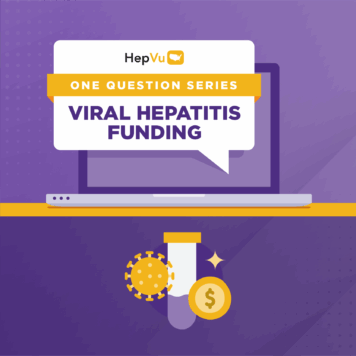Philip Spradling, MD, is a Medical Officer at the Division of Viral Hepatitis (DVH) in the Centers for Disease Control and Prevention (CDC).
Q: Your research focuses on viral hepatitis surveillance, treatment, prevention, and other related diseases such as liver cancer. What led you to this field?
One of the great things about working at the CDC is that one has the opportunity, over the course of a career, to work on a variety of public health issues involving infectious and non-infectious conditions. In my case, I have stayed put for the last 15 years in CDC’s viral hepatitis program, and I continue to find the topic fascinating and challenging.
There are a variety of pathogens involved (Hepatitis A, B, C, D, E), some of which are vaccine-preventable (Hepatitis A and B), some of which can cause chronic infection (B and C), some for which treatment is available (B and C), including curative treatment for Hepatitis C. While at CDC I have been fortunate enough to have worked on a variety of these subject areas with many wonderful colleagues in and outside of the CDC.
I consider chronic Hepatitis B the most interesting of the conditions because of its highly variable and largely unpredictable course. Current treatment for chronic Hepatitis B is not curative. Most people living with chronic Hepatitis B will not require treatment; however, all people with chronic Hepatitis B need continual, lifelong follow-up to monitor for signs of “active” disease necessitating antiviral treatment and, when indicated, clinical surveillance for liver cancer.
Q: Care cascades are useful tools to measure success in moving individuals through different stages of screening, disease awareness, linkage to care, and treatment. Can you explain each stage of the Hepatitis B care cascade and why it’s important to monitor it in the U.S.?
I absolutely agree. Care cascades have been examined for several conditions, and you have highlighted the major components of a typical cascade, or care continuum. For chronic Hepatitis B, the first step involves measures to diagnose persons with chronic Hepatitis B and the next is to look at the frequency with which these patients receive Hepatitis B-related clinical care. The next steps are to identify those patients with chronic Hepatitis B whose clinical status warrants treatment and, of those, the number who initiate treatment. And finally, determination of the number of patients who achieve complete suppression of Hepatitis B virus levels in the blood. Unfortunately, the natural history of Hepatitis B complicates this construction.
Since chronic Hepatitis B is a lifelong and, at present, incurable condition, the care continuum does not conclude with the treatment status and response for the majority of patients who may never require Hepatitis B treatment. Most with chronic Hepatitis B will need only ongoing monitoring of laboratory studies such as alanine aminotransferase and HBV viral load to watch for evidence of active hepatitis; many will eventually need ongoing ultrasound and laboratory (blood alpha fetoprotein levels) surveillance for liver cancer. Anti-viral treatment for chronic Hepatitis B is indicated when there is evidence of liver damage and active viral replication.
It is important to monitor these successive stages in care because we know that identification of patients eligible for treatment who receive appropriate antiviral therapy have a reduced risk of complications, including cirrhosis and liver cancer. And detection of liver cancer at an early stage is potentially curable and improves the chances for long-term survival.
Q: CDC DVH’s 2020 study, “The Hepatitis B Care Cascade Using Administrative Claims Data” published in the American Journal of Managed Care, used administrative claims data and health information technology to identify gaps in linkage to Hepatitis B care and treatment for commercially insured adults with chronic Hepatitis B. How can information like this be used to monitor progress towards Hepatitis B elimination in the U.S.?
This is an important paper for several reasons. For one, I believe this was the first publication to report the use of claims data to describe the Hepatitis B care cascade, and its methods can be replicated in the future to examine whether elements of the cascade have changed (ideally, improved).
In this publication, the authors examined diagnosis and linkage to care and treatment among U.S. adults using commercial claims data. Although the study was limited to people with employer health plans, it used diagnostic and procedure codes to determine whether people diagnosed with chronic Hepatitis B were truly receiving Hepatitis B-related care. Studies often define the term “linked to care” as simply an indication that an infected person received medical care of any kind; however, we know from other studies that only a fraction of diagnosed Hepatitis B patients with access to medical care get consistent Hepatitis B-related laboratory assessment. The Harris et al. paper had a high bar for the “linked to care” classification – properly so – and as a result, it was apparent that only one-third of patients received care applicable to their chronic Hepatitis B. However, the authors were able to analyze trends in linkage to care, which indicated improved linkage over time, and demonstrated that cascade data can be examined longitudinally to assess the effect of interventions to improve care. This is noteworthy given that people with chronic Hepatitis B require assessments at least annually for life.
Q: What programs and interventions are necessary to ensure people living with Hepatitis B, including medically underserved populations such as the uninsured, are aware of their disease status and linked to appropriate care?
This is a major issue because we know that medically underserved U.S. populations tend to have relatively high Hepatitis B prevalence and lack the resources to obtain — and sustain – ongoing clinical care. Hepatitis B testing and linkage to care can be achieved among disproportionately impacted populations through partnerships with community organizations, health centers, and public health departments. CDC and external partners have conducted several projects related to overcoming this challenge and have identified several interventions that improve linkage to Hepatitis B-related care among non-U.S.-born persons. These include the use of patient navigation services, community outreach through partnerships with community leaders, and conducting community-based screening events, among other measures. Demonstration projects also resulted in a more nuanced understanding of the barriers to linkage to care among populations disproportionately impacted, many of which may be amenable to improvement with a stronger public health infrastructure. For example, in the current pandemic environment, novel ways of reaching populations at risk for Hepatitis B might be realized and leveraged in the wake of public health infrastructure improvements resulting from funding and programs related to COVID-19 testing and vaccination.
Q: One of the goals from CDC’s 2025 Strategic Plan is to establish a comprehensive national viral hepatitis surveillance system. Why do we need a robust surveillance system to address the viral hepatitis epidemic in the U.S. and what are the unique challenges in Hepatitis B surveillance?
We need a comprehensive national Hepatitis B surveillance system because we cannot focus prevention and elimination efforts unless we know: 1) how many cases there are, 2) the demographic and socioeconomic characteristics of persons with Hepatitis B and risk factors associated with transmission, and 3) where these persons live geographically.
Data from the National Health and Nutrition Examination Survey (NHANES) indicate that approximately 70% of people with chronic Hepatitis B are unaware of their condition, highlighting that current risk-focused Hepatitis B testing strategies fail to identify most prevalent cases. At present, CDC is reexamining Hepatitis B testing guidelines, and a universal adult Hepatitis B testing recommendation is under consideration.
We simply must be better at finding cases of chronic Hepatitis B, and the first step in the cascade is to optimize testing strategies so we can do that. As a reportable condition in most jurisdictions, chronic Hepatitis B cases reported to health departments should be maintained in an electronic registry and updated on an ongoing basis. For the chronic cases in the registry, surveillance programs will need ongoing access to laboratory data to determine whether those persons with chronic Hepatitis B included in the registry not only have access to general medical care but are receiving Hepatitis B-related care, indicated by laboratory evidence of liver enzyme and HBV DNA (viral load) testing.
Another vital feature is the need for laboratory reporting of all related negative as well as positive results. This is critical for chronic Hepatitis B because related “normal” or “negative/undetectable” lab results are indispensable for determining response to antiviral treatment. Lab results serve as an indication to surveillance programs that Hepatitis B cases are being appropriately monitored. For those not on antiviral treatment, such results indicate that their Hepatitis B is inactive, and that treatment is not indicated. A challenge for Hepatitis B healthcare providers – which is also a challenge for surveillance programs — is detecting the presence of cirrhosis; this is important because virtually all Hepatitis B patients with cirrhosis should be treated regardless of blood test results. Access to electronic laboratory data, however, could provide insight into the fibrosis status of Hepatitis B cases in the jurisdictional registry if the laboratory results include blood markers for fibrosis (either directly or by calculation).
This is all easier said than done. The main challenges for jurisdictions involve establishing collaborations and partnerships to improve testing and reporting of cases to surveillance, having access to appropriate labs (e.g., negative HBV DNA levels), increasing electronic lab reporting for comprehensive case identification and assessment, and the capacity to readily remove duplicate records and maintenance of chronic Hepatitis B registries. Pulling in these additional data sources, which are indispensable to sound assessment of the Hepatitis B care cascade, will depend on establishing partnerships with and sharing data from local provider networks and laboratories. Of note, in 2021, CDC was able to expand its support of viral hepatitis surveillance from 14 to 59 jurisdictions, including 49 states, District of Columbia, Puerto Rico, and 8 county or city jurisdictions. With this expansion, CDC expects to see improvements over the next 5 years in the detection and response to viral hepatitis outbreaks and in the collection and analysis of data to inform the development and implementation of public health interventions to prevent and control viral hepatitis.




